Orange is associated with autumn. In our garden this colour is most evident in flowers blooming during March and April, rather than in leaves turning colour on the deciduous trees.
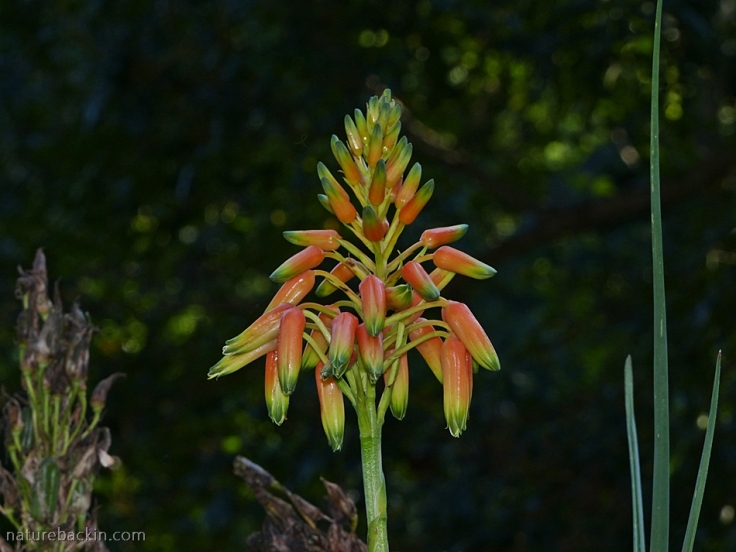
The last of five flowers that bloomed on our Aloe cooperi, which flowers in late summer
Autumn in KwaZulu-Natal is marked more by a reduction in rainfall, heat and humidity than by an autumn made spectacular by the leaves of trees turning colour in massed displays, especially insofar as most indigenous trees go. Some of the indigenous trees in our garden have only a few leaves changing colour at a time, and others drop their leaves quite suddenly late in the winter prior to the new growth of spring.

When this week I went in search of leaves that had turned to orange or red in our garden, this was one of only very few that I could find

Not orange, but at a stretch these leaves could be described as almost russet? Most of the leaves on this Tree Fuschia (Halleria lucida) remain green, but the flowers are most definintely orange, as can be seen in the photo below
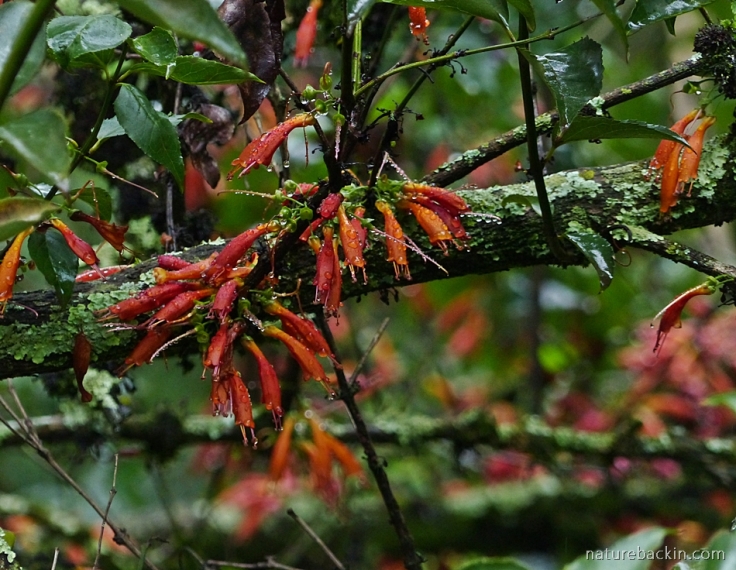
Orange flowers on the Tree Fuschia (Halleria lucida) sprinkled with raindrops from some very welcome autumn rain
The most distinguishing feature of our seasons is the distinct division between the wet and dry seasons. Spring and autumn are both brief transitional seasons. We live in a summer rainfall region – most of our rain falls in summer. Summers are hot and very, very humid, as in sub-tropical. Winters are dry and temperatures remain mostly mild, with only very light and very occasional frosts in our neck of the woods. Each winter there is snow in the Drakensberg mountains and sometimes in lower lying inland areas too. And I have just heard that the first snow of the season is forecast for the Drakensberg mountains this weekend!
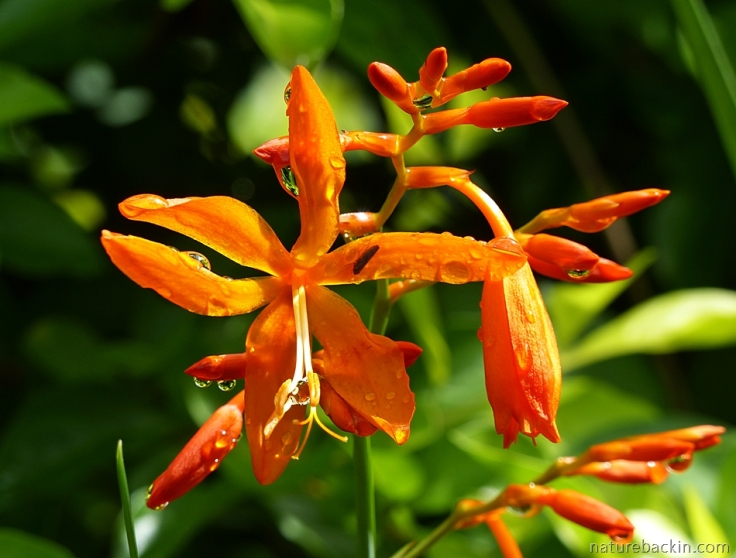
Decorated with raindrops glinting in early morning autumn sunshine is this Crocosmia aurea, or Falling Stars, though here it is usually referred to simply as ‘crocosmia’. The photo featured at the top of this post is also of a crocosmia, showing the arrangement of flowers along the plant’s slender stem

While looking out for orange flowers in the autumn garden, my eyes were drawn to this seedpod, splitting to reveal the orange-red seeds within. It belongs to the Dwarf Coral Tree (Erythrina humeana)
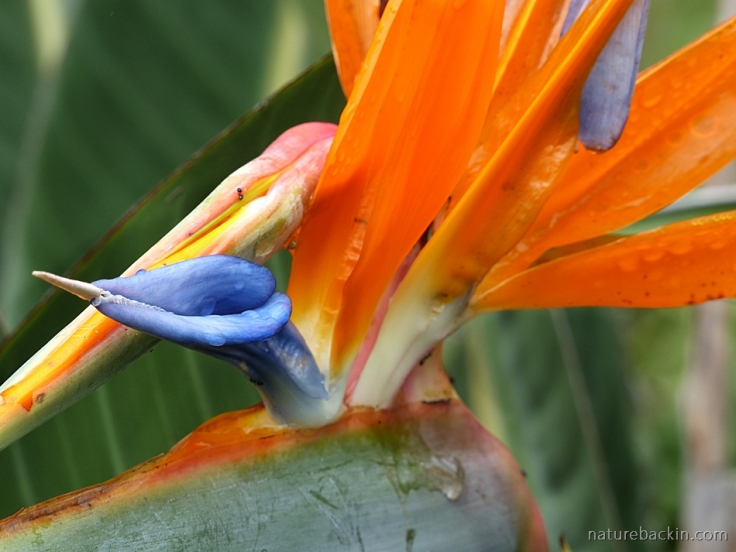
Of course I could not ignore the Strelitzia reginae, also known as the Crane Flower or Bird of Paradise Flower
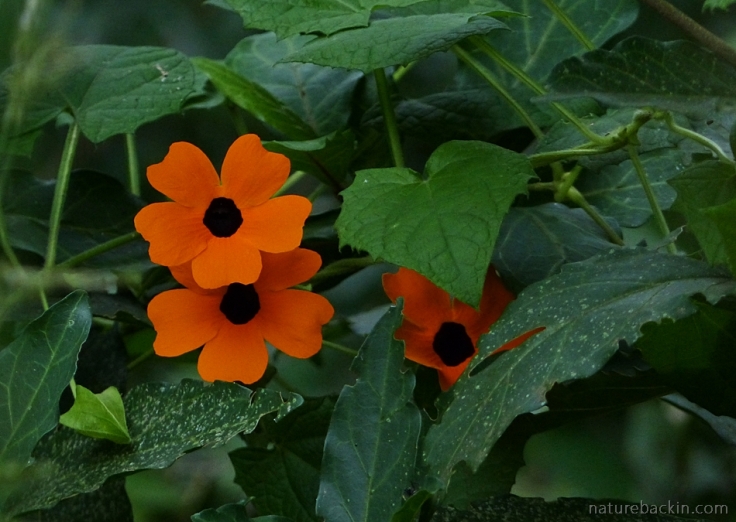
The confiding little flowers of the twining creeper Thunbergia alata, known here as the Black-eyed Susan Vine
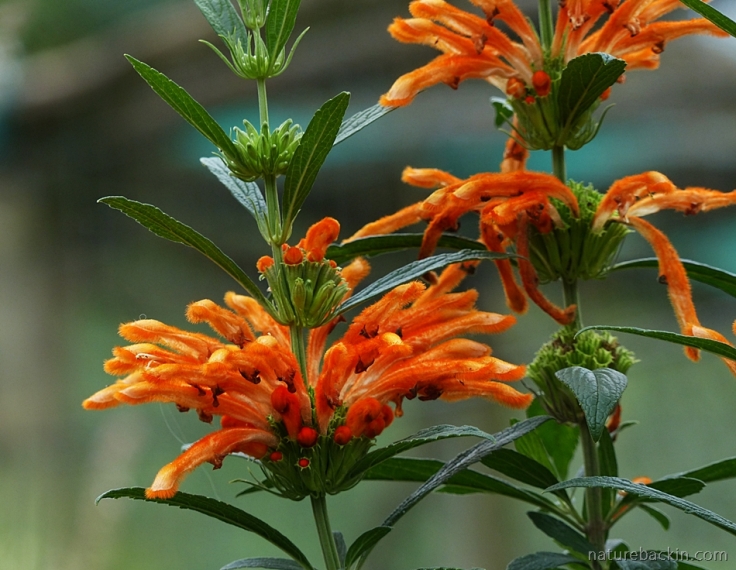
Only one of the many Wild Dagga (Leonotis leonurus) plants in the garden is in flower. Oddly the others have not even come into bud yet
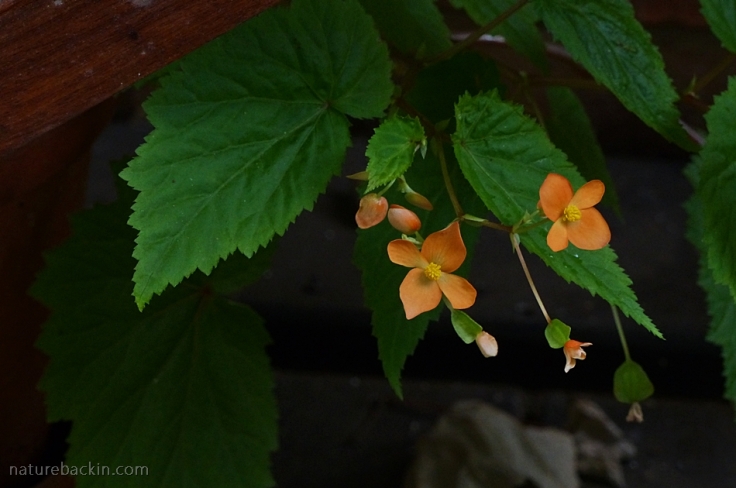
This beautiful little Wild Orange Begonia (Begonia sutherlandii), in a pot on our back deck, is a favourite of mine. I have seen it in the wild in dense forest patches in the Drakensberg mountains, growing in damp crevices and enjoying the moisture from a nearby stream or waterfall

A bit of a cheat perhaps, as this is a hybrid pelargonium, also growing in a pot on our back deck. Most pelargonium cultivars stem from the wild pelargoniums that originated in southern Africa

While photographing flowers I noticed this butterfly resting on a leaf of a Strelitzia reginae. Its markings are striking but its colours are subtle, but then it opened its wings briefly to reveal orange as can be seen in the photo below
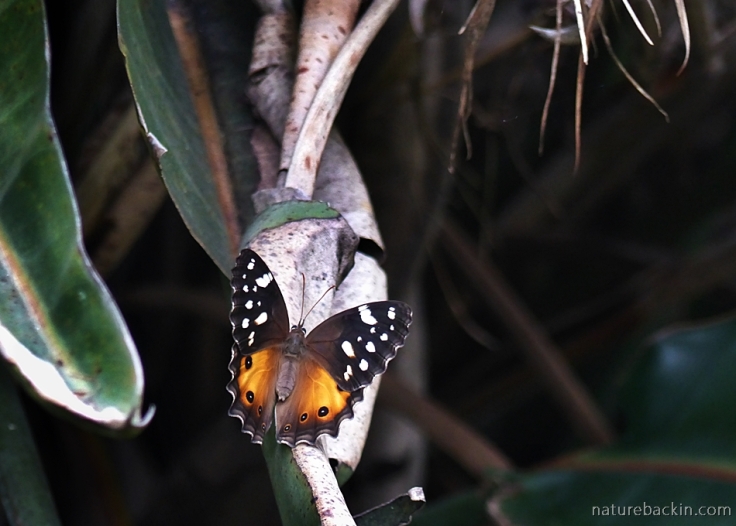
A Forest Beauty butterfly (Paralethe dendrophilus) revealing orange on the upper sides of its hind wings. The orange colouration fits in with the colour theme of this post, as does the fact that butterflies are particularly numerous and noticeable during the months of autumn
Posted by Carol









November 10, 2019 at 2:46 pm
Amazing photographs!!
I wish if only by going through your beautiful posts I can achieve a tiny bit of your talent of wonderful photography!!!
LikeLiked by 1 person
November 11, 2019 at 8:30 pm
Thanks so much for your kind comment Deeksha.
LikeLiked by 1 person
April 9, 2019 at 2:37 am
Beautiful images and your butterfly is a standout! Well done. 🙂
LikeLiked by 1 person
April 11, 2019 at 2:46 pm
Thanks very much Jane. Luckily it was one butterfly that managed to stand still long enough for me to click!
LikeLiked by 1 person
April 8, 2019 at 7:13 am
I truly enjoyed this orange theme. You have me wishing I had more flowers that bloom toward the end of summer and in orange, too. But I’m trying to go for native and, of course, that eliminates choosing a crocosmia (which grows quite exuberantly here! Almost too much so.) Funny how many flowers from your region seem to naturalize here where the climate is so very different. You are lucky to have such marvelous choices.
Finally, that gorgeous butterfly was the icing on the cake. From both sides.
LikeLiked by 1 person
April 11, 2019 at 2:44 pm
It is amazing that South African flowers adapt so well to such different climates. I am sure your native species have a charm that is quite their own, and I think its nice to have locally specific rather than homogenized gardens that are similar wherever one goes.
I agree the butterfly is gorgeous on both sides 🙂
LikeLiked by 1 person
April 7, 2019 at 7:03 pm
That is a LOT of orange! Would love to see your garden. That butterfly is simply breathtaking. Autumn is pretty green here in Mozambique!
LikeLiked by 1 person
April 11, 2019 at 2:40 pm
Thanks Lizam. We are having an unusual amount of rain this autumn, but mercifully nice and gentle and nothing dramatic.
LikeLiked by 1 person
April 11, 2019 at 6:15 pm
Lucky you. Would actually love a bit more rain (just a little bit) before the dry season.
LikeLiked by 1 person
April 7, 2019 at 5:11 am
Orange is such a cheerful color and your images are lovely. The seed pod photo is particularly striking – such a rich contrast in color. And who doesn’t like a butterfly photo. That one’s a beauty.
LikeLiked by 1 person
April 11, 2019 at 2:39 pm
Thanks Graham. We all need a little cheerful sometimes 🙂 Glad you also like the seedpod.
LikeLiked by 1 person
April 6, 2019 at 7:08 pm
Fabulous flowers but for me that butterfly steals the show!
LikeLiked by 1 person
April 11, 2019 at 2:38 pm
Thanks very much – it is a beauty. I am hoping for one to settle for longer with open wings!
LikeLiked by 1 person
April 6, 2019 at 9:49 am
Lovely collection of orange. Your autumn and our spring…I am glad that the world has such a variety of climates and seasons.
LikeLiked by 1 person
April 11, 2019 at 2:38 pm
Thanks Adele. Nice too to have a nice counterbalance of seasons. Best wishes for your spring!
LikeLike
April 6, 2019 at 3:34 am
Oh, Carol, you sure know how to end off a post full of beautiful images on a high – that Forest Beauty definitely deserves its name many times over!
LikeLiked by 1 person
April 11, 2019 at 2:36 pm
Thanks so much – yes it does exemplify its lovely name!
LikeLiked by 1 person
April 5, 2019 at 4:47 pm
Beautiful pictures of your wildflowers, Carol!! 😊
Especially the seedpod of the Dwarf Coral Tree are very special. It reminds me of the seedpod of Crocosmia. In the first moment I thought that.
And the pattern and colours of the butterfly are stunning! Such an Eyecatcher!
LikeLiked by 1 person
April 5, 2019 at 9:04 pm
Thank you Simone – yes I am partial to admiring seedpods too. It is a lovely butterfly and I mostly see it in Autumn.
LikeLiked by 1 person
April 5, 2019 at 1:53 pm
Absolutely – a feast of orange – and so often joined by purple. I think I wrote about that once…
LikeLiked by 1 person
April 5, 2019 at 9:02 pm
That’s true they are often in abundance together. I have done a post on purple flowers too, but not on orange and purple together!
LikeLike
April 6, 2019 at 5:58 am
We enjoy them even when we don’t write about them!
LikeLiked by 1 person
April 11, 2019 at 2:37 pm
🙂 🙂
LikeLike
April 5, 2019 at 12:08 pm
Wish there was a “love” button to click rather than just “like”. These are gorgeous. Didn’t even know there was a black eyed Susan vine. ❤️
LikeLiked by 1 person
April 5, 2019 at 9:01 pm
Gosh, thanks so much Irene 🙂 I think there are large daisy-like flowers in the US known as Black-eyed Susans?
LikeLiked by 1 person
April 5, 2019 at 11:33 am
Once again, loved your orange pictures!
LikeLiked by 1 person
April 5, 2019 at 9:00 pm
Thanks Suzette – and all the more cheering these orange flowers on this cool weekend.
LikeLike
April 5, 2019 at 9:28 am
Out and about yesterday, Carol, I realised I was acknowledging it was Thursday and looking forward to your post! And it’s a sumptuous post! Some of these flowers can be seen here of course – again as summer wanes – but many are exotics for us and couldn’t survive in the garden. Your butterfly photos are stunning. (Spoken with not a little envy as I have never managed to capture even a passable shot of these creatures.)
Immediately before looking at your post, I was reading another which included a poem about the colour orange – certainly a strange coincidence! I’ll add the link to the post should you wish to read it – part way down the post and not a very long piece, but a very clever poem which made me smile.
https://mybeautfulthings.com/2019/04/04/poohs-wisdom-sedums-and-a-poem/
LikeLiked by 1 person
April 5, 2019 at 8:59 pm
Thanks for your kind comment Sandra. It is only the rare butterfly I manage to capture on camera, the small minority that actually land and then stay put for long enough even when approached.
What synchronicity to read a poem about the colour orange just before seeing my post! Thanks so much for the link to it – I did enjoy the poem too.
LikeLike
April 5, 2019 at 7:43 am
All is well this morning! The plants are there in all their orange glory, and the butterflies too. Perhaps the computer was tired last night. I know the feeling.
LikeLiked by 1 person
April 5, 2019 at 8:56 pm
Glad its sorted and thanks for letting me know – strange how computers can be seemingly erratic at times!
LikeLiked by 1 person
April 5, 2019 at 5:29 am
Ah what a stunning post. 🦋Thank you for a beautiful array of pics. So pretty, you inspire me to go deeper into my own garden. 🌸have a blessed chilly weekend
LikeLiked by 1 person
April 5, 2019 at 8:55 pm
Thanks Debs. I do hope to provide inspiration for exploring the richness of small things that are under our noses so I hope you find much that is intriguing in your own garden too! You stay warm and cosy this weekend xxx
LikeLike
April 5, 2019 at 4:58 am
A beautiful array of pictures! I have five of the plants you feature in my garden too, but no sign of flowers yet in the Eastern Cape. Perhaps this is because of our long drought. It rained a little last night and we should be getting more today – thumbs up for that.
LikeLiked by 1 person
April 5, 2019 at 8:51 pm
Thanks Anne. I am so pleased that you are having some rain – may it continue tomorrow too.
LikeLike
April 5, 2019 at 4:29 am
Lovely autumnal collection Carol! xxx
LikeLiked by 1 person
April 5, 2019 at 8:50 pm
Thanks Christeen. Hope you are warm where you are this weekend as autumn starts to feel quite wintery!
LikeLiked by 1 person
April 5, 2019 at 4:07 am
A beautiful collection in shades of orange.
LikeLiked by 1 person
April 5, 2019 at 8:49 pm
Thanks very much Liz. Lovely to hear from you again.
LikeLike
April 9, 2019 at 6:31 am
Thanks Diana. Sad too are the baobabs fading away….
LikeLike
April 4, 2019 at 11:30 pm
I loved learning about your seasons, which of course, are very different than our own here. I didn’t realize your summers were so tropical. Beautiful flowers throughout, but that forest butterfly’s beauty is exceptional – it made me gasp! I love the way its camouflage looks like many eyes peering out to confuse predators. Brilliant!
LikeLiked by 1 person
April 5, 2019 at 8:49 pm
Indeed our seasons are somewhat different to yours!! I was also amazed at the delicate markings and the eyes on the butterfly with its wings closed, in such contrast to its showy markings and colour with the wings open.
LikeLiked by 1 person
April 4, 2019 at 10:09 pm
Wow, these are all beauties! 🙂 Love the Bird of Paradise, plus the butterflies!
LikeLike
April 5, 2019 at 8:47 pm
Thanks so much. The butterfly was most fortuitous!
LikeLiked by 1 person
April 4, 2019 at 9:36 pm
Orange is one of my favorite colors. Your images are simply stunning examples!
LikeLiked by 1 person
April 5, 2019 at 8:46 pm
Thank you so much Sandy. There is something about orange flowers that is especially cheering.
LikeLiked by 1 person
April 4, 2019 at 7:17 pm
Carol, I’m not quite sure what’s happened, or whether it’s a problem at my end, but only the first four images in your post are displaying. I was so looking forward to all that colour. (I blame Brexit …..)
LikeLiked by 2 people
April 4, 2019 at 7:44 pm
Oh, that is disappointing. I have checked at my end and all the images appear so not sure what to do to help. Something odd seems to be happening though as I am having trouble sending you a reply. Have just logged in again and am retrying. Brexit has a lot to answer for …
LikeLike